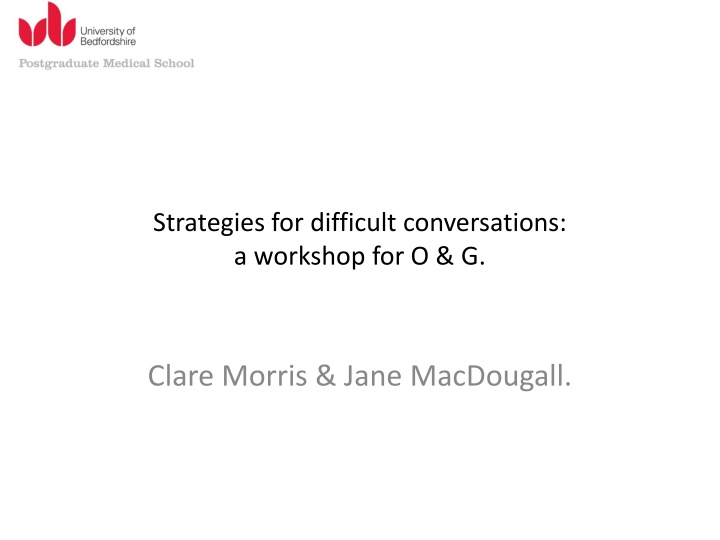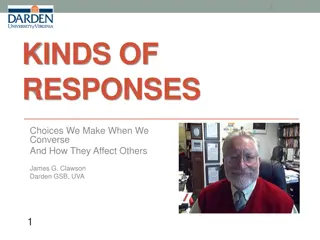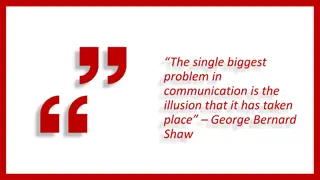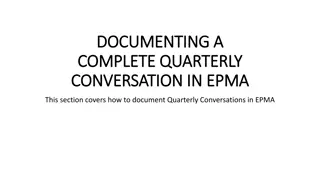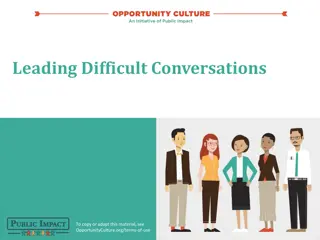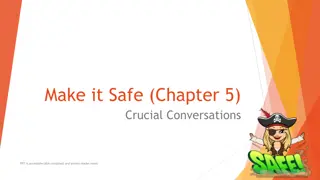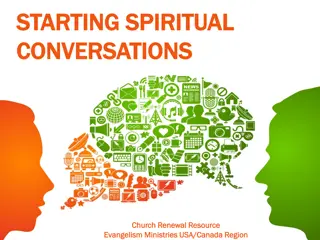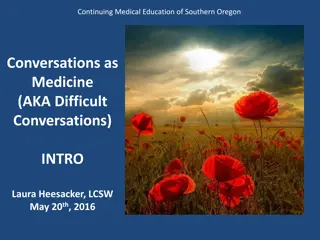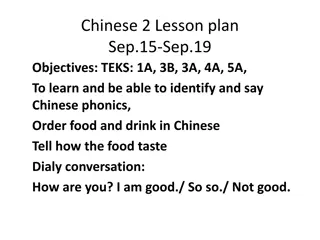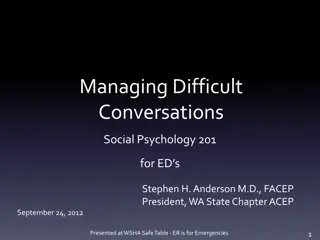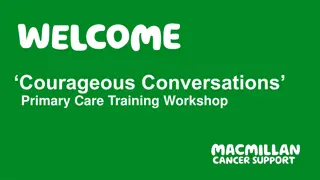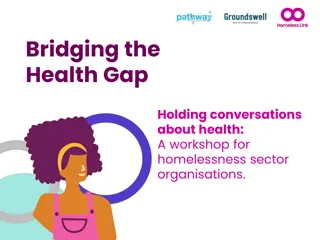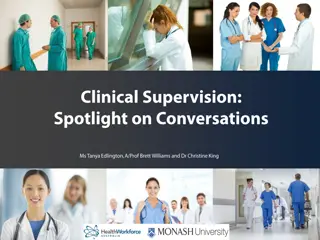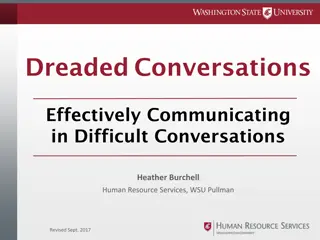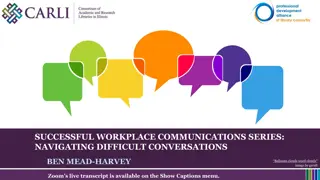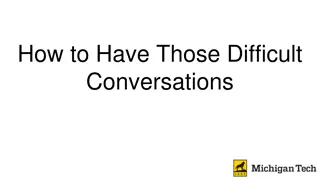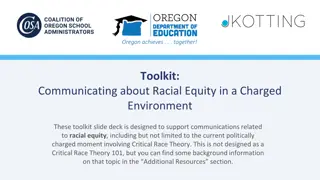Strategies for Difficult Conversations Workshop Overview
This workshop focuses on enhancing feedback skills and providing effective strategies for handling difficult situations and conversations in obstetrics and gynecology. It addresses the key premise that undermining behavior can be avoided through careful feedback, conflict management, and appropriate assertion. The workshop also explores the impact of perceived undermining on individuals, teams, and patient care, backed by literature citing consequences of interpersonal conflict and ways to transform task-related conflict into relationship-related conflict.
Download Presentation

Please find below an Image/Link to download the presentation.
The content on the website is provided AS IS for your information and personal use only. It may not be sold, licensed, or shared on other websites without obtaining consent from the author.If you encounter any issues during the download, it is possible that the publisher has removed the file from their server.
You are allowed to download the files provided on this website for personal or commercial use, subject to the condition that they are used lawfully. All files are the property of their respective owners.
The content on the website is provided AS IS for your information and personal use only. It may not be sold, licensed, or shared on other websites without obtaining consent from the author.
E N D
Presentation Transcript
Strategies for difficult conversations: a workshop for O & G. Clare Morris & Jane MacDougall.
Overview of workshop Enhanced feedback skills Strategies for difficult situations Effective strategies for difficult conversations
Key premise of this workshop Undermining behaviour can be avoided. Strategies include; careful feedback conflict management appropriate assertion
Naming the elephant Undermining by consultant What types of behaviours and/or situations may lead trainees to feel they are being undermined? What are the potential consequences of perceived undermining on individuals, on the team and on patient care?
What do the literatures report? 33% of PRHO s showing significant signs of psychological morbidity and reports of interpersonal conflict or communication problems (Paice et al 2006) Task-related and relationship-related conflict in operating room teams having negative impact on team member performance and team member satisfaction (Rogers et al 2011) Task-related conflict have relationship-related consequences (Rogers et al 2011)
Two types of conflict (Rogers et al 2011) Task-related principally cognitive in nature a perception of disagreement about content of decisions differences may be in viewpoints, ideas and opinions Relationship-related Emotional in nature a perception of inter-personal incompatibility typically includes tension, annoyance and animosity has profoundly negative effects on both team performance and team member satisfaction thought to improve group performance in specific situations, such as in the evaluation of potential problems in non-routine tasks
Conflict transformation (Rogers et al 2011) Task-related conflict can be transformed into relationship-related conflict by certain behaviours e.g. Misattribution Harsh language (insults)
Managing conflict productively (Edmonson et al 2008) Manage self Manage conversations Manage relationships
Identifying difficulties Individual task: Think about a difficult conversation you have had (or need to have) with a trainee, colleague, friend or family member note down what makes it potentially difficult for you. Pair task Compare notes and feedback factors that seem to make conversations difficult
Transferrable skills? Think about the ways in which you (and other skillful clinicians) break bad news What are your best practice guidelines? What do you do to look after yourself in these situations?
Managing self? Watch the brief clip and consider a) in what ways this trainer s behaviour could be perceived as undermining b) how you might guide both the trainer and the trainee in terms of response options (including what they might do differently next time) RCOG: Video 2. Consultant bad day http://vimeo.com/13551401 Watch from 0:35 to 2:40
In contrast to Undermining Definition: Damage or weaken (someone or some- thing)esp. gradually or insidiously Thesaurus: Sabotage, threaten, weaken, compromise, damage, impair, diminish
MANAGE CONVERSATIONS Critique Feedback Appropriate assertion
One sentence definitions How would you define the following words Criticism [noun] Critical [adjective] Critique [verb]
One sentence definitions Criticism [noun]: the expression of disapproval of someone or something based on perceived faults or mistakes Critical [adjective]: expressing adverse or disapproving comments or judgments Critique [verb]: a detailed analysis and assessment of something
A feedback framework Place Purpose Next steps Time Feedback
Developing practice Watch this short video clip of a trainer talking to their trainee about their management of a patient a few days ago Suggest some immediate ways in which this trainer might improve their handling of this situation RCOG Video 7: Giving criticism http://vimeo.com/13554287 Watch from 1: 40 to 3:50
On the ward, visible to all, sister present but not engaged consultant asked to see her tell me about the case then recent set of nights constant worry for past few days middle of busy ward round You re going to have to do a lot better than this if you want to succeed in this career next time sister have someone watch her Feedback mode Closed questions with no time to respond Sarcasm how very fortunate when you could be bothered to come back etc
What might you do differently? Place Purpose Next steps Time Feedback
Feedback: first principles Think about experiences you have had of both giving and receiving feedback from others. Why is feedback important? What works in feedback? What can influence the ways in which feedback is received (by the trainee)?
Why? Identifies current strengths and weaknesses and future learning / development needs Provides guidance for future practice Helps develop the capacity to critically evaluate own and others performance, to self monitor and move towards professional autonomy
What works? Encourage independent review, reflection and self-evaluation Base feedback on observation not inference Be descriptive not evaluative Be specific and offer supporting examples
What works continued Select priority areas and limit the amount of feedback on any one occasion Focus on behaviour that can be changed - not personal characteristics Suggest specific ways to improve performance
Power differentials Personal Professional Positional Expertise Resource What do you see as the power differentials between trainer trainee? How might this effect the ways in which challenge, critique or feedback is perceived?
Appropriate assertion Regular, two-way developmental conversations should be the basis of all supervisory relationships with trainees Some circumstances however require different types of conversations e.g. challenging behaviour
aggressive Assertive communication Expressing ourselves without putting ourselves or others down. indirectly aggressive passive
Why assertiveness aids efficient communication It avoids / reduces the risk of: misunderstanding withdrawal hurting people unnecessarily The negative impact of power difference spending energy on non-productive activities, e.g. self criticism, justifying, repairing communicationbreakdowns It can: address process issues empower all concerned
Key elements & principles of assertion training 1. Expressing positive feelings 2. Expressing negative feelings 3. Setting limits No (What I don t want) 4. Setting initiation - Yes (What I want) 10-11-2011
The Assertive Verbal Message (DOH!) DIRECT - Minimise chance of misunderstanding OWNED -I feel, I believe, my experience HONEST- What I feel not what I should feel - latter will seep through.
Appropriate assertion a model Describe the behaviour you d like to see changed Describe effects of behaviour (without judgment or criticism) Use I rather than you to label impact Be clear about preferred behaviour /change expected Don t make assumptions about motivations and reasons listen as well as tell Tone should be as neutral as possible
Helpful forms of words When you [describe behaviour] Then [consequences] I feel [label] I would prefer [describe behaviour]
An exemplar: late for theatre You are so irresponsible arriving at this time, I can t believe you weren t here first. This has got to stop, it is totally unacceptable. [when you] You were due here at 8 am and it is now 8.20. [then]The theatre list is already running late as a result. [I feel] I feel frustrated and pressured. [ I prefer]I would like you to be on time for theatre or contact X if there is going to be any delay in future.
Non-Verbal factors Eye contact (or lack of it) Tone of Voice, Gestures Facial Expression Body Position Distance Congruence with each other + verbal message Timing
Setting limits - degrees of muscle Aim: A framework for considering how to challenge others Method: Polite low level statement setting limits Intensify verbal + non-verbal Inform of consequences Carry out consequences
Being the best trainer you can be Excellent supervision What typifies the best educational or clinical supervision you have experienced, witnessed or offered? What are the observable characteristics of the excellent trainer?
Thank you! Clare Morris: clare.morris@beds.ac.uk Acknowledgement: with thanks to my colleague Linda Jones for enhanced communication skills elements of this workshop.
